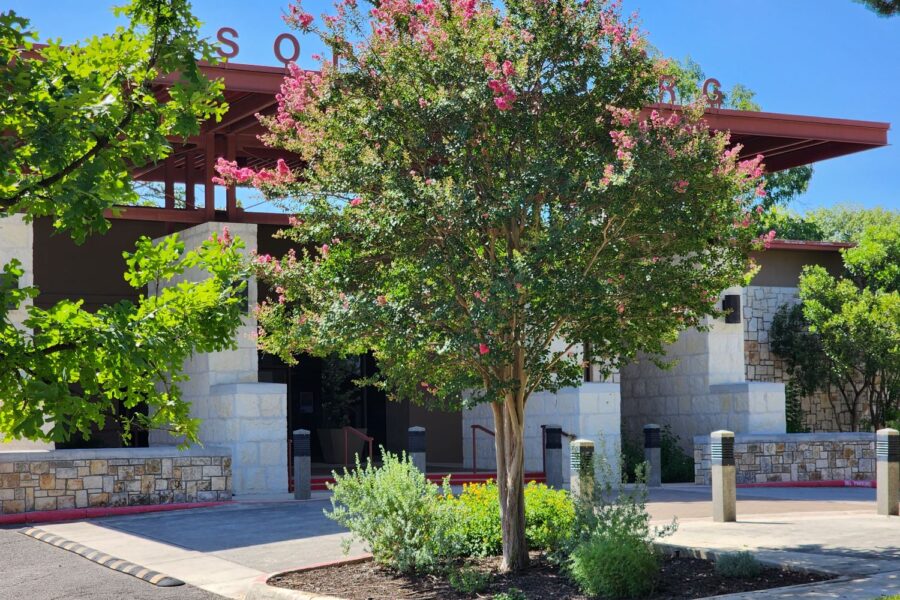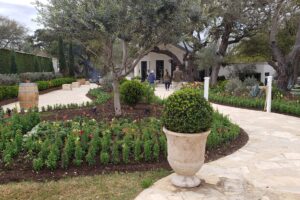Destination New Braunfels
At 9 am on an overly hot Tuesday morning in August, we begin our westward trek toward New Braunfels. Someone named Sophie has a museum there — I don’t get the connection. I ask our friend, who organized this little adventure for three, exactly how to pronounce the name of the attraction we are about to visit – Sophienburg Museum. I understand the Sophie part, even the burg. It is the n in the middle of everything that has me stumped. My friend isn’t sure of the pronunciation either. Hmmm.
I have been visiting New Braunfels, a small town of German origin, east of San Antonio, since I was knee-high to a grasshopper. During my youth and beyond, its sirens lure sang many songs of water and fun and picnics, schnitzel, sausages, and family. I thought I had heard them all, but today it sings a different tune in breathless whispers of its past. Of its people. Its origins. A love story.
When Michael’s GPS announces our destination is on the right, I am shocked by the size and location of the Sophienburg Museum — it is much larger than I imagined! Located in the middle of an old New Braunfels neighborhood and shaded by what seems to be a thousand trees in the surrounding area and on the museum grounds, I can’t help but wonder why — why this spot? I am sure the answer must lie somewhere behind the gleaming double glass doors.
The Sophienburg


Standing here in the vestibule-type entrance, I see a hint of what may be in store—a glass display case filled with three stories — shelves for the unimaginative — of sturdy looking and rustic, early Texas pioneer-era dollhouse furniture. You can’t help but love it, imagining the child who played make believe with the small furnishings.
To the right of the reception desk is a library chronicling the German immigration into Texas. When Michael asks about doing research here, there are more than a few requirements. I’m not sure any of them apply to us. A bit disappointed, we turn and begin our journey into the past.
Stopping in small room adjacent to the museum proper, we learn via a small screen video that the museum stands on a hill — I think it is more of a knoll — that was initially the site of a proposed fort for protection against hostile forces to the west. Prince Carl Solms, the founder of New Braunfels, named it Sophienburg for the woman he loved, Princess Sophie von Salm-Salm who was still in Germany while he was in Texas.
“…so her name will always be remembered on this side of the ocean, I will name a fortress, which will be built for the protection of New Braunfels…”
Texas State History Online
The prince returned to Germany on May 5, 1845, less than three months after he led the first German immigrant train to this spot. He married the woman he loved on December 5, of that same year and never returned to Texas or the Americas.
Other People’s Lives at the Sophienburg Museum
Now that my question about Sophie is answered, but not the pronunciation of the museum’s name, we step through a doorway and peer into the relics of centuries past and the story of the prosperous town our immigrant forefathers built on the banks of the beautiful Comal River. Winding our way past a reimagined portion of the interior of the ship that brought the German families to Texas, we proceed down a long hallway filled with displays on either side. This path leads to the dining area of a home ready for a party — perhaps a baby shower? The women sporting hats and gloves and dressed in their Sunday best.
Tucked in a corner of the room is an old-fashioned recliner that once belonged to Robert E. Lee. Fascinating — you must read the story for yourself!


New Braunfels Main Street Recreated
Eventually we come to the long-ago world of the butcher the baker and the candlestick maker, the doctor’s office, the pharmacy, the saloon, and other businesses necessary for a thriving town in Central Texas. Passing by the doctor’s office, I see two Victorian-era prosthetic legs. On a table in the adjacent room is a long thin knife lying on a table. Thankful that I live in the 21st century rather than the 19th, I move on.

Standing in front of the bakery’s window, I marvel at the large whisk in front of me. I wonder when they were invented, I know I couldn’t cook or bake without the stash of whisks, in various shapes and sizes, that sit in a container on my kitchen counter.
On the top shelf, I see the oddest kitchen tool. It is designed to roll and to cut, but I can’t imagine what. Next to me, Michael says, “Hot dog buns.”
I don’t think so; I snap a photo and take it to the museum attendant and she explains it was to cut strips of dough for cinnamon rolls so they were uniform in shape and size. I am impressed at the ingenuity, wondering who invented it and what bakeries use today.
Whispers of the Past
We walk on, and I see a display of schoolbooks and workbooks. I think of my mother, raised on a farm, the daughter of 1st generation German immigrants, attending school in a one-room schoolhouse; smart as a whip, she wanted to learn more and chose to attend the 8th grade twice — the highest level of education offered to her and her eight siblings. I remember Mom showing me one of her schoolbooks when I was in my early teens. Sadly, at that time, I didn’t appreciate a thirteen-year-olds diligent efforts to learn the art of farming, with A+’s filling each page. Looking at it now, through older eyes, my jaw drops and I am filled with awe at the detail of the drawings and the writings that follow. Her penmanship was beautiful too.



Peeking into the local dry goods store, nostalgia overtakes me. I am four years old, back on my grandmother’s farm in South Texas. My aunt is churning butter for the week from the thick, rich cream she recently separated from the milk. It looks like such fun; I want to try it. I remember begging. Finally, she relents and lets me try. My thin little arm tires in less than five minutes, and nothing has happened inside the butter churn. My aunt returns to the seemingly impossible task at hand.


We continue looking, thinking, imagining, dreaming. This snapshot of a Main Street from long ago, makes me want to tell the world, “Come spend time in New Braunfels. Come see the Sophienburg Museum. Walk in the footsteps of old ghosts. Learn about determination, ingenuity, invention, hard work, and dreams. Remember your own.”
Museums grace our world for a reason.
The Sophienburg Museum

- 401 West Coll Street in New Braunfels, Texas 78130
- Hours: Tuesday – Saturday, 10 am to 4 pm.
- Admission: Adults – $8, Students 13 to 18 – $4, 6 to 12 – $2
- Phone: 830.629.1572
- For more information, visit their website at www.sophienburg.com
Prince Carl Solms- The Founder of New Braunfels
Although only touching Texas for a small percentage of his life, Prince Carl Solms has a story in its own right. Aside from “putting away his first wife and their three children,” if you access Texas State History On-line.
https://www.tshaonline.org/handbook/entries/solms-braunfels-prince-carl-of
Your eyes may open as wide as mine as I read the brief history of what brought the prince to Texas, why he didn’t return and what he did afterward.
Don’t be put off by the first paragraph, but rather be amazed by his name and his birth.
“Friedrich Wilhelm Carl Ludwig Georg Alfred Alexander, Prince of Solms, Lord of Braunfels, Grafenstein, Münzenberg, Wildenfels, and Sonnenwalde, the first commissioner-general of the Adelsverein and imperial field marshal, was born at Neustrelitz on July 27, 1812, the youngest son of Prince Friedrich Wilhelm of Solms-Braunfels and Princess Friederike of Mecklenburg-Strelitz.”
Texas State History Online
And then there is the eye-widening excerpt of his memoir transmitted to Queen Victoria in England.
“Carl also wrote a fifty-nine-page memoir, transmitted to Queen Victoria in 1846, in which he explained that Europe and the westering United States were on a collision course to dominate world trade. America would likely win this race, Carl told the queen, if the United States reached the Pacific. He offered containment through colonization, the establishment of a powerful monarchy in Mexico, and the emancipation of the slaves as England’s surest policy.”
Texas State History Online
For another look at the world of New Braunfels and what is going on in the 21st century, click of the following link:









2 Comments
Leave your reply.